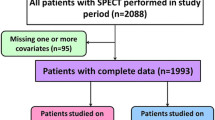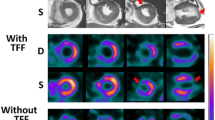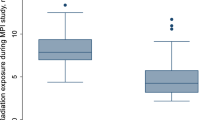Abstract
Purpose
Injected doses are difficult to optimize for exercise SPECT since they depend on the myocardial fraction of injected activity (MFI) that is detected by the camera. The aim of this study was to analyse the factors affecting MFI determined using a cardiac CZT camera as compared with those determined using conventional Anger cameras.
Methods
Factors affecting MFI were determined and compared in patients who had consecutive exercise SPECT acquisitions with 201Tl (84 patients) or 99mTc-sestamibi (87 patients) with an Anger or a CZT camera. A predictive model was validated in a group of patients routinely referred for 201Tl (78 patients) or 99mTc-sestamibi (80 patients) exercise CZT SPECT.
Results
The predictive model involved: (1) camera type, adjusted mean MFI being ninefold higher for CZT than for Anger SPECT, (2) tracer type, adjusted mean MFI being twofold higher for 201Tl than for 99mTc-sestamibi, and (3) logarithm of body weight. The CZT SPECT model led to a +1 ± 26 % error in the prediction of the actual MFI from the validation group. The mean MFI values estimated for CZT SPECT were more than twofold higher in patients with a body weight of 60 kg than in patients with a body weight of 120 kg (15.9 and 6.8 ppm for 99mTc-sestamibi and 30.5 and 13.1ppm for 201Tl, respectively), and for a 14-min acquisition of up to one million myocardial counts, the corresponding injected activities were only 80 and 186 MBq for 99mTc-sestamibi and 39 and 91 MBq for 201Tl, respectively.
Conclusion
Myocardial activities acquired during exercise CZT SPECT are strongly influenced by body weight and tracer type, and are dramatically higher than those obtained using an Anger camera, allowing very low-dose protocols to be planned, especially for 99mTc-sestamibi and in non-obese subjects.


Similar content being viewed by others
References
Imbert L, Poussier S, Franken PR, Songy B, Verger A, Morel O, et al. Compared performance of high-sensitivity cameras dedicated to myocardial perfusion SPECT: a comprehensive analysis of phantom and human images. J Nucl Med. 2012;53(12):1897–903.
O’Connor MK, Bothun E, Gibbons RJ. Influence of patient height and weight and type of stress on myocardial count density during SPECT imaging with thallium-201 and technetium 99m-sestamibi. J Nucl Cardiol. 1998;5(3):304–12.
Thompson RC, Heller GV, Johnson LL, Case JA, Cullom SJ, Garcia EV, et al. Value of attenuation correction on ECG-gated SPECT myocardial perfusion imaging related to body mass index. J Nucl Cardiol. 2005;12(2):195–202.
Robinson CN, van Aswegen A, Julious SA, Nunan TO, Thomson WH, Tindale WB, et al. The relationship between administered radiopharmaceutical activity in myocardial perfusion scintigraphy and imaging outcome. Eur J Nucl Med Mol Imaging. 2008;35(2):329–35.
Notghi A, Williams N, Smith N, Goyle S, Harding LK. Relationship between myocardial counts and patient weight: adjusting the injected activity in myocardial perfusion scans. Nucl Med Commun. 2003;24(1):55–9.
Notghi A, Sundram FX, O’Brien JW, Smith NB. Assessing the effect of increasing injection activity for myocardial perfusion imaging in overweight patients. Br J Radiol. 2008;81(969):730–4.
Heller GV. Tracer selection with different stress modalities based on tracer kinetics. J Nucl Cardiol. 1996;3(6 Pt 2):S15–21.
Kailasnath P, Sinusas AJ. Comparison of Tl-201 with Tc-99m-labeled myocardial perfusion agents: technical, physiologic, and clinical issues. J Nucl Cardiol. 2001;8(4):482–98.
Ayalew A, Marie PY, Menu P, Mertes PM, Hassan N, Danchin N, et al. A comparison of the overall first-pass kinetics of thallium-201 and technetium-99m MIBI in normoxic and low-flow ischaemic myocardium. Eur J Nucl Med. 2000;27(11):1632–40.
Ayalew A, Marie P-Y, Menu P, Mertes P-M, Audonnet S, Jouan V, et al. (201)Tl and (99m)Tc-MIBI retention in an isolated heart model of low-flow ischemia and stunning: evidence of negligible impact of myocyte metabolism on tracer kinetics. J Nucl Med. 2002;43(4):566–74.
Verger A, Djaballah W, Fourquet N, Rouzet F, Koehl G, Imbert L, et al. Comparison between stress myocardial perfusion SPECT recorded with cadmium-zinc-telluride and Anger cameras in various study protocols. Eur J Nucl Med Mol Imaging. 2013;40(3):331–40.
Marie PY, Danchin N, Branly F, Angioï M, Grentzinger A, Virion JM, et al. Effects of medical therapy on outcome assessment using exercise thallium-201 single photon emission computed tomography imaging: evidence of a protective effect of beta-blocking antianginal medications. J Am Coll Cardiol. 1999;34(1):113–21.
Marie PY, Mercennier C, Danchin N, Djaballah K, Grentzinger A, Zannad F, et al. Residual exercise SPECT ischemia on treatment is a main determinant of outcome in patients with coronary artery disease treated medically at long-term with beta-blockers. J Nucl Cardiol. 2003;10(4):361–8.
David N, Marie PY, Angioi M, Rodriguez RM, Hassan N, Olivier P, et al. Dipyridamole and exercise SPET provide different estimates of myocardial ischaemic areas: role of the severity of coronary stenoses and of the increase in heart rate during exercise. Eur J Nucl Med. 2000;27(7):788–99.
Marie P-Y, Djaballah W, Franken PR, Vanhove C, Muller MA, Boutley H, et al. OSEM reconstruction, associated with temporal Fourier and depth-dependant resolution recovery filtering, enhances results from sestamibi and 201Tl 16-interval gated SPECT. J Nucl Med. 2005;46(11):1789–95.
Nakazato R, Berman DS, Hayes SW, Fish M, Padgett R, Xu Y, et al. Myocardial perfusion imaging with a solid-state camera: simulation of a very low dose imaging protocol. J Nucl Med. 2013;54(3):373–9.
Einstein AJ, Moser KW, Thompson RC, Cerqueira MD, Henzlova MJ. Radiation dose to patients from cardiac diagnostic imaging. Circulation. 2007;116(11):1290–305.
Mouden M, Timmer JR, Ottervanger JP, Reiffers S, Oostdijk AHJ, Knollema S, et al. Impact of a new ultrafast CZT SPECT camera for myocardial perfusion imaging: fewer equivocal results and lower radiation dose. Eur J Nucl Med Mol Imaging. 2012;39(6):1048–55.
Duvall WL, Croft LB, Ginsberg ES, Einstein AJ, Guma KA, George T, et al. Reduced isotope dose and imaging time with a high-efficiency CZT SPECT camera. J Nucl Cardiol. 2011;18(5):847–57.
Gimelli A, Bottai M, Giorgetti A, Genovesi D, Filidei E, Marzullo P. Evaluation of ischaemia in obese patients: feasibility and accuracy of a low-dose protocol with a cadmium-zinc telluride camera. Eur J Nucl Med Mol Imaging. 2012;39(8):1254–61.
Gimelli A, Bottai M, Genovesi D, Giorgetti A, Di Martino F, Marzullo P. High diagnostic accuracy of low-dose gated-SPECT with solid-state ultrafast detectors: preliminary clinical results. Eur J Nucl Med Mol Imaging. 2012;39(1):83–90.
Leppo JA, Meerdink DJ. Comparison of the myocardial uptake of a technetium-labeled isonitrile analogue and thallium. Circ Res. 1989;65(3):632–9.
Marshall RC, Leidholdt Jr EM, Zhang DY, Barnett CA. Technetium-99m hexakis 2-methoxy-2-isobutyl isonitrile and thallium-201 extraction, washout, and retention at varying coronary flow rates in rabbit heart. Circulation. 1990;82(3):998–1007.
Strauss HW, Bailey D. Resurrection of thallium-201 for myocardial perfusion imaging. JACC Cardiovasc Imaging. 2009;2(3):283–5.
Acknowledgments
The authors thank Henri Boutley for his help in image analysis, Pierre Pothier for critical review of the manuscript, and the Nancy University Hospital for financial and organizational support.
Conflicts of interest
None.
Author information
Authors and Affiliations
Corresponding author
Rights and permissions
About this article
Cite this article
Verger, A., Imbert, L., Yagdigul, Y. et al. Factors affecting the myocardial activity acquired during exercise SPECT with a high-sensitivity cardiac CZT camera as compared with conventional Anger camera. Eur J Nucl Med Mol Imaging 41, 522–528 (2014). https://doi.org/10.1007/s00259-013-2617-2
Received:
Accepted:
Published:
Issue Date:
DOI: https://doi.org/10.1007/s00259-013-2617-2




